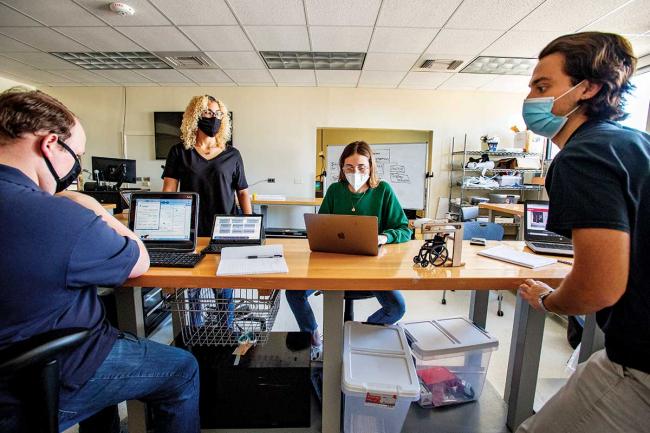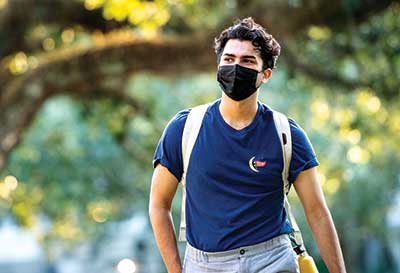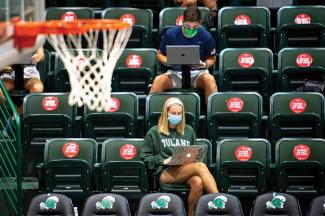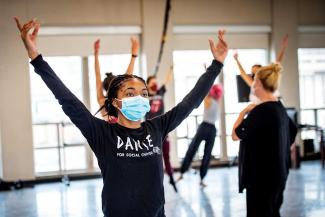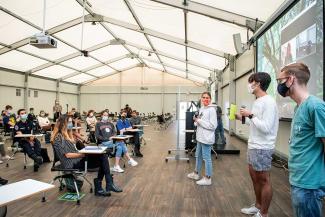Katherine Raymond, a professor of practice in the Department of Biomedical Engineering at the School of Science and Engineering and co-director of undergraduate studies in biomedical engineering, served on the school’s task force that met during the summer.
The group was “extremely committed and collaborative,” she said. “I think that really enabled us to come into fall with a sense of confidence and the ability to understand the expectations of what we could do and how we could make it work for our students.
Students and faculty adjusted to a new way of learning and teaching, said Raymond. About teaching in the new temporary classrooms, she said, “We spent the first days of the semester with the students and professors having a lot of patience.”
With the new, enhanced equipment, students have the option, with their professor’s permission, to remotely log in to classes, particularly if they are not feeling well, are quarantining or aren’t fully comfortable being there in person.
“It’s convenient and safer for me to sometimes just Zoom in on my classes,” said junior Frankie Gaynor, a School of Liberal Arts double major in political science and communication from Coral Springs, Florida. “I appreciate having that option.”
First-year student Kaalan Day, an economics major from Los Angeles, described classes as being “pretty normal” other than not being able to sit close to classmates. He realizes, though, that he is missing the typical college freshman experience, especially in a city like New Orleans.
“It does suck not having club expos and going to big events and festivals, but I know eventually it’s going to get here. It’s extra hard because it’s freshman year. And this is the year we’re supposed to make connections and meet people.”
One way in which Day has been able to connect with the city is through Newcomb-Tulane College’s Reading Project selection for the first-year class, The Yellow House by Sarah M. Broom.
“Reading the book gave me new perspective on some things,” Day said of the book, which is about the loss of a family home during Katrina. “I’ve heard about the hurricanes and the destruction,” he said. But learning about Broom’s experience with people passing by her house after the storm, as voyeurs taking pictures of what her family had lost, was eye-opening.
As part of the effort to keep everyone on campus safe and healthy, the university initiated the Stronger TUgether: Be COVID Safe campaign. The pillars are to remind the community to wear face coverings, maintain a 6-foot distance from people not in their household, limit gatherings to no more than 15 people and frequently wash hands.
On the Tulane website, a COVID-19 Dashboard displays results from the university’s virus testing of students and employees.
On-campus students who test positive for the virus may isolate in Paterson Residence Hall, which is staffed with medical personnel. If a student is a close contact to someone who has been exposed to the virus, the university provides rooms at the Hyatt Regency Hotel in which to quarantine, in a separate tower from other guests.
Nothing Is the Same
When “everything erupted” in March, Kyla Denwood, a senior in the School of Liberal Arts majoring in political science with a minor in Spanish, said the hardest part for her about transitioning to online classes was having time cut short with friends who had to leave campus or return home.
She said she realized, “Nothing is going to be the same from this point on.”
Denwood was staying off campus but in New Orleans, when the announcement occurred. She returned to her home in Chicago in August.
Denwood previously had plans to study in Scotland this fall, and with special permission she is studying abroad now. She petitioned Tulane, verifying that the COVID-19 case count in the area of Scotland where she planned to study was less than in New Orleans. In addition, she provided a contingency plan in the event COVID-19 becomes prevalent in Scotland.
Denwood is hearing the messages about how the actions of students may have an effect on the New Orleans community.
Even though she isn’t on campus for the fall semester, she is happy to see messaging on social media promoting COVID-19–responsible behavior among students.
Spreading the virus “is the last thing that we want to be doing to a majority Black community in the middle of a global racial reckoning, in the middle of a global pandemic,” said Denwood.
After making the transition to remote coursework during the spring semester, Isaac Hoeschen of Milwaukee said, “I’m glad that all of my friends are in New Orleans again.”
The junior economics major in the School of Liberal Arts said, “I can socially distance with masks on and still see all those people on a regular basis.”
Hoeschen is concerned with the public health risk that the Tulane student body poses to the residents of New Orleans. However, he is impressed with how the student body adapted to taking the precautions to mitigate the virus’s spread seriously.
“I think the student body is doing an incredibly good job of following guidelines on campus.”
Resiliency
Leslie Scott, assistant professor in the Department of Theatre and Dance at the School of Liberal Arts, is teaching the Newcomb Dance Company course this fall in McWilliams Hall.
The class requires “a certain type of floor, a large open space and has a communal aspect,” said Scott. The students are collaborating, in a socially distanced way, to create a short dance film in lieu of the traditional in-person final performance.


